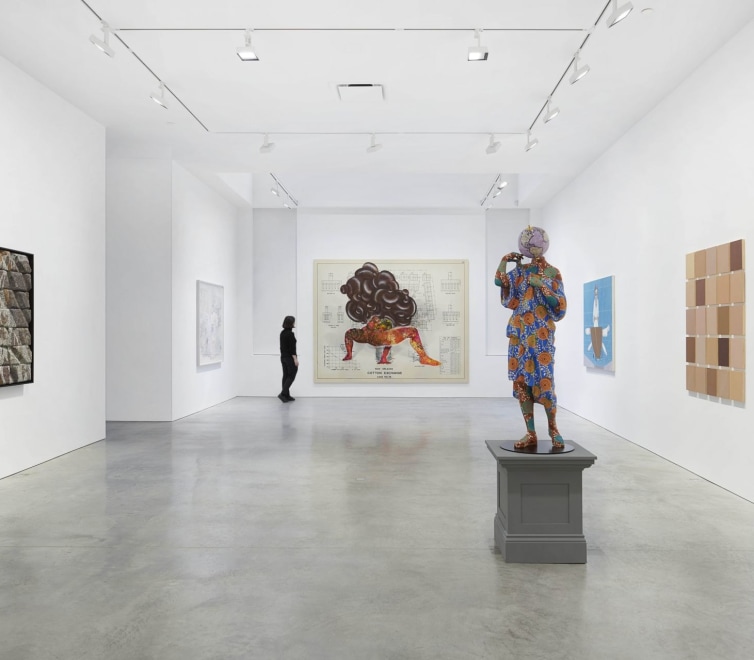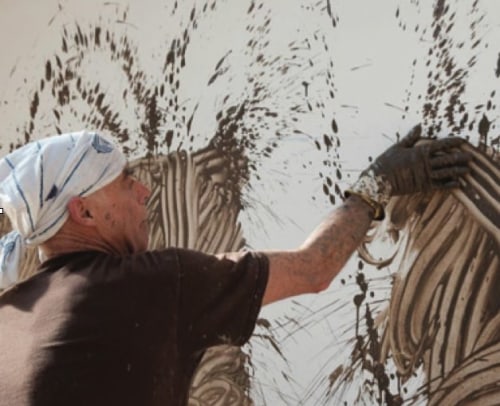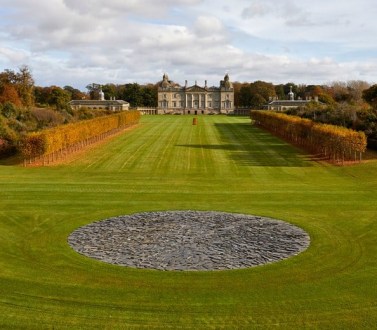
RICHARD LONG
Untitled, 1998
River Avon mud on Sandstone
Diameter: 18 1/2 in.
46.99 cm
JCG0324
RICHARD LONG
Vermont Georgia South Carolina Wyoming Circle, 1987
Red, white, gray, green stones
Diameter: 291 in.
739.1 cm
JCG1195
RICHARD LONG
Red Slate Circle, 1987
Jagged red slate stones
Diameter: 236 1/4 in.
600.1 cm
JCG5920
RICHARD LONG
Brownstone Circle, 2000
Brownstone
Diameter: 180 in.
457.2 cm
JCG0372
RICHARD LONG
Untitled, 2007
China Clay with acrylic medium and paint on wood
86 5/8 x 49 1/4 in.
220 x 125.1 cm
JCG3856
RICHARD LONG
Untitled, 2003
River Avon mud with acrylic medium and paint on wood
48 3/8 x 48 3/8 in.
122.9 x 122.9 cm
JCG1939
RICHARD LONG
Walking A Line by the Footpath, 2002
Photograph
44 x 32 in.
111.8 x 81.3 cm
JCG1416
RICHARD LONG
A Thousand Stones Thrown into the River Yangtze, Yunnan, China, 2010
Unique color photograph
33 7/16 x 42 1/2 in.
84.9 x 108 cm
JCG9033
RICHARD LONG
Untitled, 2010
Yangtze River mud on wood
20 5/8 x 13 1/8 x 1 7/8 in.
52.4 x 33.3 x 4.8 cm
JCG4744

Considered one of the most influential artists of his generation, Richard Long’s works have extended the possibilities of sculpture beyond traditional materials and methods. Central to Long’s work is the activity of walking. Since the mid-1960s he has taken countless walks throughout the world, in such places as the Sahara Desert, Australia, Iceland and near his home in Bristol, United Kingdom. The walks bring together physical endurance and principles of order, action and idea. From these walks emerge the idea and material for his works. Long’s sculptures commonly take the form of geometric shapes—circles, lines, ellipses, and spirals – and are often composed of minerals native either to their location or to the British countryside Long has traveled by foot. He similarly sources mud and earth from his expeditions for use in performative paintings done on canvas or directly onto the wall.
Richard Long was born in 1945 in Bristol, United Kingdom and studied at the West of England College of Art before continuing on to the St. Martin’s School of Art and Design, London in 1966. Long represented Britain in the British Pavilion at the 1976 Venice Biennale and was awarded the Turner Prize in 1989. Long’s work has been the subject of solo exhibitions at major international museums and institutions, including the De Pont Museum, Tillburg, Netherlands; San Francisco Museum of Modern Art, San Francisco; Scottish National Gallery of Modern Art, Edinburgh, Scotland; Musée d'Art Moderne et d'Art Contemporain, Nice, France; and the Tate Modern, London, United Kingdom. In 1990 he became a Chevalier dans l’Ordre des Arts et des Lettres from the French government and was awarded the highest international distinction for achievement in the arts, the Praemium Imperiale Prize for Sculpture in 2009. Long’s work is included in many prestigious public and private collections worldwide, including the Tate, London, United Kingdom; the Museum of Modern Art, New York; National Gallery of Canada, Ottawa, Canada; and the Musée d'Art Moderne de la Ville de Paris, Paris, France. Richard Long lives and works in Bristol, United Kingdom.
Considered one of the most influential artists of his generation, Richard Long’s works have extended the possibilities of sculpture beyond traditional materials and methods. Central to Long’s work is the activity of walking. Since the mid-1960s he has taken countless walks throughout the world, in such places as the Sahara Desert, Australia, Iceland and near his home in Bristol, United Kingdom. The walks bring together physical endurance and principles of order, action and idea. From these walks emerge the idea and material for his works. Long’s sculptures commonly take the form of geometric shapes—circles, lines, ellipses, and spirals – and are often composed of minerals native either to their location or to the British countryside Long has traveled by foot. He similarly sources mud and earth from his expeditions for use in performative paintings done on canvas or directly onto the wall.

